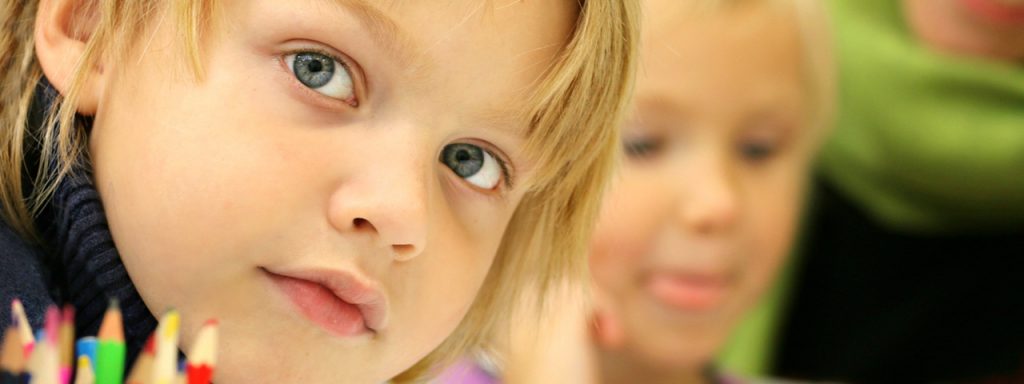
Did you know that 80% of learning is visual and learning-related vision problems account for 20% of all learning disabilities? It is so important that vision problems are detected early and this can only be done through a comprehensive eye examination. Fortunately, OHIP covers the cost of annual eye exams for children 19 years old and younger.
Preschool Children: 2-5
The toddler and preschool age is a period when children experience drastic growth in intellectual and motor skills. During this time they will develop the fine motor skills, hand-eye coordination and perceptual abilities that will prepare them to read and write, play sports and participate in creative activities such as drawing, sculpting or building. This is all dependent upon good vision and visual processes.
This is the age when parents should be on the lookout for signs of lazy eye (amblyopia) – when one eye doesn’t see clearly, or crossed eyes (strabismus) – when one or both eyes turn inward or outward. The earlier these conditions are treated, the higher the success rate.
Parents should also be aware of any developmental delays having to do with object, number or letter recognition, color recognition or coordination, as the root of such problems can often be visual. If you notice your child squinting, rubbing his eyes frequently, sitting very close to the tv or reading material, or generally avoiding activities such as puzzles or coloring, it is worth a trip to the eye doctor.
School-Aged Kids: Ages 6-18
Undetected or uncorrected vision problems can cause children and teens to suffer academically, socially, athletically and personally. If your child is having trouble in school or after school activities there could be an underlying vision problem. Proper learning, motor development, reading, and many other skills are dependent upon not only good vision, but also the ability of your eyes to work together. Children that have problems with focusing, reading, teaming their eyes or hand-eye coordination will often experience frustration, and may exhibit behavioral problems as well. Often they don’t know that the vision they are experiencing is abnormal, so they aren’t able to express that they need help.
In addition to the symptoms written above, signs of vision problems in older children include:
- Short attention span
- Headaches
- Frequent blinking
- Avoiding reading
- Tilting the head to one side
- Losing their place often while reading
- Double vision
- Poor reading comprehension
The Eye Exam
In addition to basic visual acuity (distance and near vision, or refractive errors) an eye exam may assess the following visual skills that are required for learning and mobility:
Binocular vision: how the eyes work together as a team Focusing Peripheral Vision Color Vision Hand-eye Coordination Tracking
The doctor will also examine the area around the eye and inside the eye to check for any eye diseases or health conditions. You should tell the doctor any relevant personal history of your child such as a premature birth, developmental delays, family history of eye problems, eye injuries or medications the child is taking. This would also be the time to address any concerns or issues your child has that might indicate a vision problem.
Myopia in Children
Myopia (nearsightedness) is occurring in children more frequently, at a younger age and to a greater degree than ever before. Unfortunately, childhood myopia leads to a high prescription come adulthood, resulting in thick glasses or a dependence on contact lenses.


Sunday hours are available by appointment.